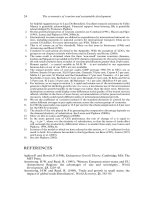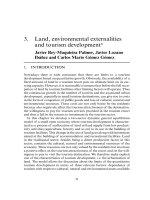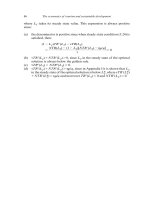THE ECONOMICS OF MONEY,BANKING, AND FINANCIAL MARKETS 415
Bạn đang xem bản rút gọn của tài liệu. Xem và tải ngay bản đầy đủ của tài liệu tại đây (49.63 KB, 1 trang )
CHAPTER 15
Central Banks and the Bank of Canada
383
FO RMAL STRU CT U RE O F TH E BAN K OF C AN ADA
The overall responsibility for the operation of the Bank of Canada rests with a
Board of Directors, which consists of fifteen members the governor, the senior
deputy governor, the deputy minister of finance, and twelve outside directors. The
Board appoints the governor and senior deputy governor with the government s
approval, for a renewable term of seven years. The outside directors are appointed
by the minister of finance, with Cabinet approval, for a three-year term, and they
are required to come from all regions of Canada representing a variety of occupations with the exception of banking. The governor of the Bank is the chief executive officer and chairman of the Board of Directors. Currently, the governor of
the Bank of Canada is Mark Carney (see the Inside the Central Bank box, The
Political Environment and the Bank of Canada).
In 1994 the Board of Directors made some changes in the internal organization of the Bank. Most prominently the Board established a new senior decisionmaking authority within the Bank called the Governing Council. The Council
is chaired by the governor and is composed of the senior deputy governor and
four deputy governors. Since this change, the six members of the Governing
Council of the Bank collectively assume responsibility for the Bank s new semiannual Monetary Policy Report, published in April and October, and its Update,
published in January and July. This system of collective responsibility ensures
that the Bank s governor is not personally identified with the Bank s policy.
THE FU NC TI O NS O F TH E BAN K OF CAN ADA
In the words of the preamble of the Bank of Canada Act, the functions of the Bank
of Canada are
to regulate credit and currency in the best interests of the economic life of the nation,
to control and protect the external value of the national monetary unit and to mitigate by its influence fluctuations in the general level of production, trade, prices and
employment, so far as may be possible within the scope of monetary action, and
generally to promote the economic and financial welfare of Canada.
INSIDE THE CENTRAL BANK
The Political Environment and the Bank of Canada
Since the inception of the Bank of Canada there
have been eight governors:
1935
1955
1961
1973
1987
1994
2001
2008
1954, Graham Towers
1961, James Coyne
1973, Louis Rasminsky
1987, Gerald Bouey
1994, John Crow
2000, Gordon Thiessen
2007, David Dodge
, Mark Carney
It is interesting to note that during the same
period, Canadians went to the polls more than
twenty times to elect a federal government. The
Bank of Canada is not completely independent
from the government. For example, the government can directly influence the Bank by not
renewing the governor s appointment when it
expires, as the Liberal government did in 1994
when it didn t renew the appointment of John
Crow, who was appointed by the Conservative
government in 1987.









